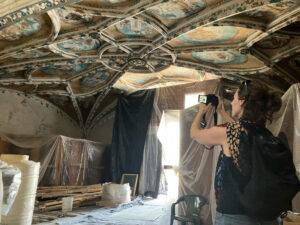Savannah Esquivel specializes in the art and material culture of the Hispanic Americas, with a particular emphasis on Mexico. Her research focuses on the artistic and sociopolitical interventions made by Nahua communities within Christian religious spaces in colonial Mexico. Current article-length projects investigate the soundscape of Franciscan convent churches, landscape mural painting and the ecological impacts of settler-colonialism in the Puebla-Tlaxcala Valley, and discourses of Indigenous presence and absence in Spanish colonial sources and art historical methodologies. She is at work on a book-length project, tentatively titled Indigenous Insiders: Sights, Sounds, and Cross-Cultural Interactions in Mexico’s Early Colonial Monasteries, which examines how Indigenous communities used Franciscan convents— their imagery, sounds, spaces, and institutional structure—to challenge settler-colonialism in colonial Mexico.
Esquivel is a Faculty Affiliate of the UCLA Center for 17th- & 18th-Century Studies and the William Andrews Clark Memorial Library. In 2023-2024, Esquivel will be the Fletcher Jones Foundation Fellow in The Huntington-UC Program for the Advancement of the Humanities, an innovative partnership designed to advance the humanities at public universities.
Education
2020 University of Chicago, Art History
2011 University of Illinois at Chicago, Art History
2009 University of Iowa, Art History and Religious Studies
Areas of Specialization and Primary Research/Teaching Interests:
Art and material culture of the ancient and colonial Americas, with a focus on architecture and mural painting in contexts of religious conversion in Mexico. Indigenous studies; Nahuatl language and culture; art and ecology; mendicant art and architecture.
Monograph
“Indigenous Insiders: Sights, Sounds, and Cross-Cultural Interactions in Mexico’s Early Colonial Monasteries” (in preparation).
Invited Articles
“Pipes, Pigments, and Posas: Tapping into the Divine in Early Colonial Mexican Architecture,” postmedieval, special issue on “Technique: Alternate Histories of Expertise and Experiment,” edited by Jennifer Jahner and Jessica Rosenberg (under review).
“Haunted Monasteries: Troubling Indigenous Erasure in Early Colonial Mexican Architecture” Arts 13, no. 2: 61 (2024). Recipient of the Association for Latin American Art 2024 Article Award
https://doi.org/10.3390/arts13020061
“Hearing and Seeing Indigenous Presence in a Colonial Mexican Church (Tecamachalco, 1562),” in Soundscapes of the Early Modern Iberian Empires, ed. Víctor Sierra Matute (Abingdon, England; New York, NY: Routledge: 2024).
“More Mortar, More Problems: Ecologies of Renaissance Classicism in Sixteenth-Century Mexico” (in progress).
Articles
“Taking Camaxtli Prisoner: Spoliated Monuments and Captive Art in Early Colonial Mexico” (in preparation)
“Uprooting Landscape: Drought and Land Degradation in Colonial Mexican Murals” (under review).
Academic Book Reviews
“New Spain’s Second City: Architecture and Urbanism of Puebla de los Ángeles,” Architectural Histories (2024). https://doi.org/10.16995/ah.15240
Review of Rosario I. Granados, ed. Painted Cloth: Fashion and Ritual in Colonial Latin America (University of Texas Press and Blanton Museum of Art, 2023) for caa.reviews. Published online Aug. 30, 2023. http://www.caareviews.org/reviews/4146
Review of Tony Ballantyne, Lachy Paterson & Angela Wanhalla, eds. Indigenous Textual Cultures: Reading and Writing in the Age of Global Empire (Duke, 2020) for Native American and Indigenous Studies 9, no. 2 (Fall 2022): 195-197.
Review of Ana Pulido Rull, Mapping Indigenous Lands: Native Land Grants in Colonial New Spain: Native Land Grants in New Spain (University Oklahoma Press, 2020) for Ethnohistory 69, no. 3 (2022): 366–367.

